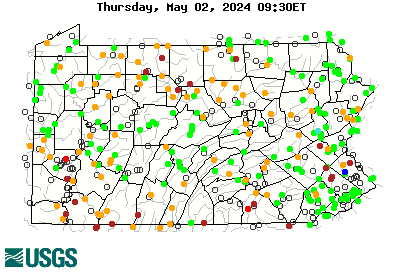You are using an out of date browser. It may not display this or other websites correctly.
You should upgrade or use an alternative browser.
You should upgrade or use an alternative browser.
Euro - What BH Tungsten Weight(s) Are you Typically Fishing?
- Thread starter Letort
- Start date
I'm no expert, but fishing a mono-rig is, in my opinion, an extremely easy thing to do. I know it's not the "right way," but I use differing amounts of split shot depending on conditions. My nymphs are always tied about the same weights regardless.
Streammagic237
Member
A dry fly 🙃. One day I will learn euro .
dudemanspecial
Well-known member
2.3's 2.8's and 3.3's will do most of the work for you. Size 14-20 flies. Pheasant tails, walts worms and perdigons. Thin profiles to sink fast.
Those are jig hook size beads. If you are using regular style hooks the tungsten beads for those are a little lighter sized. Just get in the ballpark of what I listed above either way.
Those are jig hook size beads. If you are using regular style hooks the tungsten beads for those are a little lighter sized. Just get in the ballpark of what I listed above either way.
Last edited:
FlyLikeTheFish
New member
Agree with dudemanspecial and would add to get slotted beads. For ESN, the goal is getting the fly in the strike zone as quickly as possible after the cast, with a fast sink that still enables a natural drift. Think through what best achieves that in your setup and fly selection. There's a reason the saying is, "thin for the win".
As you do it more, you'll learn which sizes tend to work best for you. Majority of my ESN flies are sz 16-18, and I still weigh them a decent bit.
Finally, a lot of folks tie with copper beads. Try to be different, especially on a well fished or pressured water.
As you do it more, you'll learn which sizes tend to work best for you. Majority of my ESN flies are sz 16-18, and I still weigh them a decent bit.
Finally, a lot of folks tie with copper beads. Try to be different, especially on a well fished or pressured water.
GoldenRfly
Active member
I was out with a guide earlier this year and asked him the same question specifically related to Nymphing. 2.8mm and 3.3mm slotted tungsten beads were the answer on size 16 jig hooks. I often start with a Prince that also has lead wire underneath the peacock hurl. I use size 14 Nymph hooks too.
Last edited:
Nymph-wristed
Well-known member
@dudemanspecial 's advice will get you in the game.
There is no right answer, however. It depends on the presentation you need and conditions. I am not always tight, for example. That is limiting, and the mono rig is not designed to be limiting.
It would be better to tie 3 patterns like walts, frenchie, and perdigon (or whatever your confidence patterns are) in several weights and hook sizes.
For example, water is low AF right now in NEPA, so for me to catch fish yesterday, I was throwing the lightest tungsten bead possible (that pairs correctly with the size hook, of course).
I hate shot, so I carry extra tungsten beads to slide on the line. That makes the point of contact the fly. I can fish a size 16 perdigon or frenchie in 4 feet of heavier water by adding another 2.8 mm to the mix without changing the size of the fly that is working.
Tightlining in heavy water, yes, you want heavy flies to get down in the zone quickly. But in low water, quiet runs and slicks, you don't want 1) the big bead making noise as it enters the water with a plop, and 2) sometimes you want a slow fall not a quick descent to the bottom.
There is no right answer, however. It depends on the presentation you need and conditions. I am not always tight, for example. That is limiting, and the mono rig is not designed to be limiting.
It would be better to tie 3 patterns like walts, frenchie, and perdigon (or whatever your confidence patterns are) in several weights and hook sizes.
For example, water is low AF right now in NEPA, so for me to catch fish yesterday, I was throwing the lightest tungsten bead possible (that pairs correctly with the size hook, of course).
I hate shot, so I carry extra tungsten beads to slide on the line. That makes the point of contact the fly. I can fish a size 16 perdigon or frenchie in 4 feet of heavier water by adding another 2.8 mm to the mix without changing the size of the fly that is working.
Tightlining in heavy water, yes, you want heavy flies to get down in the zone quickly. But in low water, quiet runs and slicks, you don't want 1) the big bead making noise as it enters the water with a plop, and 2) sometimes you want a slow fall not a quick descent to the bottom.
Last edited:
dudemanspecial
Well-known member
Why have I never thought of this?????I hate shot, so I carry extra tungsten beads to slide on the line. That makes the point of contact the fly. I can fish a size 16 perdigon or frenchie in 4 feet of water by adding another 2.8 mm to the mix.
Regardless, I am no expert and for various reasons I don't really "euronymph" much anymore, but do keep a leaf in my nymph box dedicated for these flies because they flat out work. Going to add a little pack of beads now thanks to your post!
Nymph-wristed
Well-known member
Tungsten is more bang for your buck than lead and less bulky. It's a good way to use up those countersunk beads, too 😉Why have I never thought of this?????
Regardless, I am no expert and for various reasons I don't really "euronymph" much anymore, but do keep a leaf in my nymph box dedicated for these flies because they flat out work. Going to add a little pack of beads now thanks to your post!
Duriensbane
Active member
if you are using straight shank hooks, the offset beads work wonders, you can use them on jig hooks as well, which forces the hook to do a headstand.
typical nymphs - 2.6-3.3 as others have said
small stuff (18-20) 2.2 or 2.0
jig streamers - 3.8 - 4.6 (add lead wraps if needed)
typical nymphs - 2.6-3.3 as others have said
small stuff (18-20) 2.2 or 2.0
jig streamers - 3.8 - 4.6 (add lead wraps if needed)
An old rule of thumb was to get to depth in 3 seconds. Heavier and you may hang up to much; lighter and you may not get into the zone. That said, I have had luck the last year fishing shallower than I used to with plenty of action and not many flies lost.
Also tend to use smaller flies each year. In normal/low conditions 18/20 is the norm with occasional 16s
Also tend to use smaller flies each year. In normal/low conditions 18/20 is the norm with occasional 16s
Mikey2006
Well-known member
My go to setup on rivers of similar size to those is a 3 or a 3.2mm bead for my bottom fly and a 2.8mm for my tag, when I’m using a double nymph rig. Sometimes I’ll use a 2.8 for both. I don’t think I ever really go bigger than 3.2, because if the flows were high enough that I needed to I would be streamer fishing insteadWhat do you find yourself typically tying on, given normal water conditions on streams like Yellow Breeches, Penns, Spring, etc?
JSky
Member
I tie a ton of euro nymphs and fish all types of water across the country. I use a mix of 2.4, 2.8, and 3.2 mm beads. I tie them on size 14 and 16 fulling mill jig force hooks. I also use the fulling mill beads shown here.






